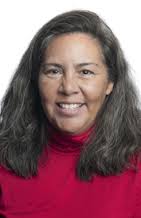Recently, the National Indian Council on Aging (NICOA) spoke with Roxane Spruce Bly, a member of the Pueblo of Laguna, who has been leading the ACA outreach and enrollment effort for American Indian/Alaska Natives (AI/AN) in New Mexico. Ms. Spruce Bly brings invaluable experience in the field of health policy research, analysis, and development. She is the Director of Healthcare Education and Outreach for Native American Professional Parent Resources (NAPPR), Inc. NAPPR is one of two navigator entities in New Mexico.
She reflects that the Affordable Care Act (ACA) got off to a rocky start but her team turned that barrier into an opportunity to focus on outreach and education. The older Indians they target are those in the 55–64 age group, too young to receive Medicare and yet perhaps ready to plan for their retirement or address a long standing health issue. Ms. Spruce Bly is excited to get the message out about health insurance in New Mexico. Her theory of change is that once people increase their knowledge they will in turn change their behavior. Her initial approach resulted in 441 inquiry calls which led to 269 appointments, culminating in 244 individuals signing up for coverage.
Ms. Spruce Bly shared two remarkable success stories. One self-employed older couple too young for Medicare signed up and found a plan for 32 cents a month, with no cost sharing, no co-insurance, and no co-pay. They were also able to assist an older man who was paying over $400 a month for Medicare part A; once he signed up he was able to get the same coverage for $6.00 a month.
One of the biggest barriers for her team is the perception that the Indian Health Service System (IHS), the historically underfunded healthcare system used by most AI/ANs will continue to provide coverage. Actually IHS is not insurance and, because it is underfunded, having affordable insurance is a good way to provide peace of mind. This insurance is most critical when a medical procedure that cannot be completed at IHS is needed for a family member. Health insurance coverage for urban Indians and reservation Indians is equally important. No matter where you live, insurance coverage is important for your family.
In order to reach consumers, she says that her team needs to make five “touches” to create awareness of the marketplace and to encourage them to enroll. These touches can take the form of print ads, TV spots, radio PSAs, or talking with one of her team members. The team is composed of tribal community members because in outreach, local is best. People want to talk with someone they know about health insurance.
Ms. Spruce Bly‘s outreach team uses a “Roping” technique to find the people they are trying to reach. Outreach happens where people gather: gas stations, buses, laundromats, post offices, and malls. The outreach team is skilled and comfortable at drawing people out, “roping them in” and asking them open questions that help spark conversations. And if you are waiting for your laundry, you may welcome someone to talk to while you watch your clothes tumbling around.
The people she has hired are passionate about the work and want to bring health insurance to everyone in their community. They can speak with people in a variety of native languages (Pueblo, Navajo and Apache) which always increases the sense of ease when talking about important issues. When they hear an interested consumer cannot attend an outreach event due to lack of transportation or childcare, they will then arrange a home visit and bring along a laptop with secure access to the Internet to overcome sometimes spotty internet access. The goal is to minimize the number of steps consumers take to make an appointment.
Once a person is ready to sign up, Ms. Spruce Bly has learned that it is best to have another team member skilled in enrollment procedures to handle that aspect. Actually it works best if the team member is not someone they know. The enrollment process can be uncomfortable and many personal questions need to be answered for the person to receive the best possible insurance plan. They may not want to share these details with a person from their own community, because confidentiality is always a concern. Some areas in New Mexico have been very effective in enrolling AI/ANs. For example the Eight Northern Pueblos of New Mexico (Taos, Picuris, Santa Clara, Ohkay Owingeh/formerly San Juan, San Ildefonso, Nambé, Pojoaque, and Tesuque) have contacted, educated and enrolled a large number of AI/ANs.
Ms. Spruce Bly says that it comes down to a person’s comfort level with risk. Some don’t want to live with uncertainty and prefer the peace of mind that health insurance brings. Her goal is that in several years, AI/ANs will create a culture of coverage and will become empowered consumers. These consumers will expect and receive quality healthcare.
For more information on outreach efforts to tribes in New Mexico, please contact Ms. Spruce Bly. You can also listen to Ms. Spruce Bly discuss the ACA and its benefits for New Mexico AI/ANs in this YouTube video.
Be Well New Mexico: “How Does the New Mexico Health Insurance Exchange Benefit American Indians?”
For New Mexico AI/AN elders wishing to sign up for insurance coverage offered by the Affordable Care Act, please contact Native American Professional Parent Resources (NAPPR).
For information on AI/AN aging, please contact the National Indian Council on Aging, Inc. (NICOA).
Rebecca Owl Morgan is a Project Coordinator at the National Indian Council on Aging, Inc. (NICOA). The opinions expressed in this article are those of the author and do not necessarily reflect those of the Diverse Elders Coalition.


